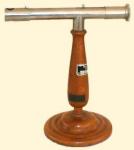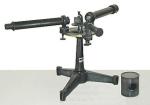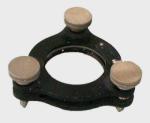 Menu
Menu
|
Function To study the dispersion of light. |

| ||
|
|||
|
Description The support has a variable height and it leans on a heavy basis that assures the stability of the prism. The polyprism is composed of four kinds of glass with a different dispersive power. | |||
|
Function To study the refraction. |

| ||
|
|||
|
Description The prism is cut from a block and has a cylindrical cavity connected to an opening closed by a tap polished with emery. The lateral sides are represented by two plates with perfectly parallel sides, which are worked in such a way on the planes that they stick to the prism sides by simple pressure. | |||
|
Function To explain the functioning of the achromatic lens. |

| ||
|
|||
|
Description It stands on a support with variable height. The two prisms, the crown one , with a 15 degrees 15 minutes angle, the other in flint, with a 8 degrees 6 minutes, both calculated on the basis of the glass quality that is used. They are held by a horizontal plate and stuck on two columns turning on their axis. By using the two prisms separately, we notice the images of the objects appear displaced and coloured on the edges. If we use them in pair, we still have the deviation across the two prisms, but we do not obtain the colouration. | |||
|
Function To study the dispersion of light. |

| ||
|
|||
|
Description The conical prism produces a spectrum similar to that of the rainbow. | |||
|
Function To study the spectrum of a luminous source. |

| ||
|
|||
|
Description Small school model with Amici’s prism, a variable slit, an achromatic field lens and an eye achromatic lens. | |||
|
Function To study the spectrum of a luminous source. |

| ||
|
|||
|
Description It is supplied by a flint (n=1.64) equilateral prism. The tube has a photographic scale with a mobile prism and an achromatic lens. The telescope has a friction ocular. | |||
|
Function To study the light diffraction. |
 ( (
| ||
|
|||
|
Description The slit is obtained between two nickel silver plates with sharp and rectilinear edges. One of them is fixed, the other, sliding between two parallel guides, is controlled by a screw with a friction drum, divided into 50 equal parts, so that the opening is given in hundredths of millimetre. An antagonist spring eliminates any clearance of the screw and internal thread. The diaphragm that holds the split has two perpendicular cones, so that we can dispose the slit horizontally or vertically on its foot. The column allows 12 cm vertical displacements. | |||
 Menu
Menu
|
Function To see the interference of the light. |

| ||
|
|||
|
Description Two 100 mm diameter glass disks are closed between two strong circular frames, that we can tighten with three setscrews. One of the disks has plane surfaces, the other has one spherical surface. | |||
|
Function To study the light interference. |

| ||
|
|||
|
Description The apparatus is used to produce interference fringes. Each black mirror is fixed on a darken brass frame with three screws, that allow the separated adjustment of the two mirrors. The angle is changeable with a micrometric screw, the metallic support has a changeable and variable height. | |||
|
Function To study the light interference. |

| ||
|
|||
|
Description The apparatus is used to produce interference fringes. Each black mirror is fixed on a darken brass frame with three screws, that allow the separated adjustment of the two mirrors. The angle is changeable with a micrometric screw, the metallic support has a changeable and variable height. | |||